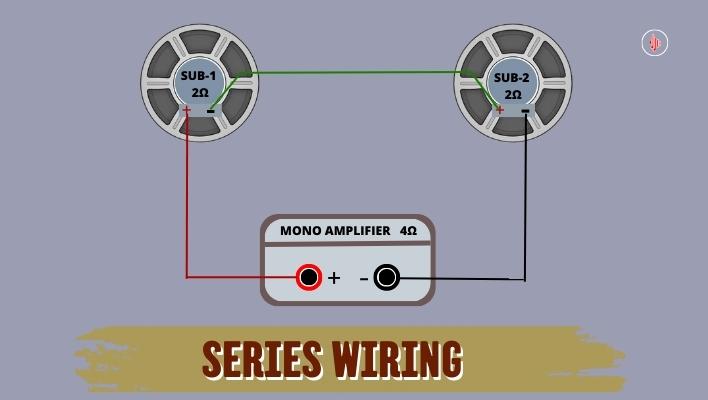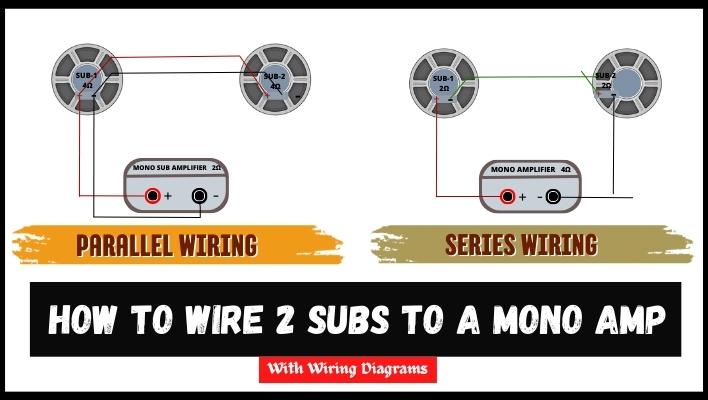Subwoofers are designed to be used with amplifiers to provide low-frequency sound reproduction. The amplifier provides the power required to drive the subwoofer, allowing it to reproduce accurate low-frequency sounds with sufficient volume.
The process of wiring a subwoofer to an amplifier depends on the type of subwoofer and amplifier being used, but in general, the subwoofer will need to be connected to the amplifier’s output terminals using speaker wires. In addition, matching a subwoofer with an amplifier is crucial for optimal performance and to avoid damaging the equipment.
How to Wire a Subwoofer to an Amplifier
As we have stated, there are several ways to wire a subwoofer to an amplifier, depending on the type of subwoofer and amplifier being used, as well as the desired configuration. The ideal setup will often require specific types of wiring configurations, such as;
- Single Voice Coil (SVC) configuration- A single voice coil subwoofer has one coil, and can be wired to an amplifier using a single set of positive and negative speaker wire connections.
- Dual Voice Coil (DVC) configuration- A dual voice coil subwoofer has two coils, which can be wired in parallel or series to create different impedance options. Wiring the coils in parallel will result in a lower impedance load while wiring them in series will result in a higher impedance load.
- Bridged mode- Some amplifiers have a bridged mode that allows them to deliver more power to a single subwoofer. This involves connecting the subwoofer to both the left and right channels of the amplifier and then bridging the two channels to create a single channel with more power.
Wiring 2 Subwoofers to Mono Amp
Mono amplifiers are designed to power a single subwoofer or a set of subwoofers that are wired together in parallel or series. Using a mono amp for 2 subs can be a great way to get powerful and high-quality bass in a car or home audio system, plus it can provide more power and control than cheap multi-channel amplifiers.
To wire 2 subs to a mono amp it is important to make sure that the total impedance of the subwoofers matches the impedance range supported by the amplifier. Mismatched impedance can cause the amplifier to overheat, reduce the power output, or even damage the equipment. You should also ensure that the subwoofers are compatible with the amplifier in terms of power handling and sensitivity.
The next step involves determining the ideal wiring configuration for your setup. There are two basic ways to wire two subwoofers to a mono amplifier i.e. in series or in parallel.

Series Wiring
Wiring subwoofers in series offers several benefits, but the most obvious advantage would be an increase in impedance. When you wire subwoofers in series, you connect the positive terminal of one subwoofer to the negative terminal of the other subwoofer. This configuration adds the impedance of both subwoofers together.
Here are the steps for wiring 2 subs to a mono amp in series;
- Check the impedance rating of your subwoofers and your amplifier and make sure they are compatible. For example, if you have two 2-ohm subwoofers and a mono amplifier that can handle a 4-ohm load, you can wire them in series to create the 4-ohm load.
- Connect one end of a speaker wire to the negative terminal of the first subwoofer and the other end to the positive terminal of the second subwoofer.
- Connect the positive terminal of the first subwoofer to the negative terminal of the amplifier.
- Connect the negative terminal of the second subwoofer to the positive terminal of the amplifier.
Once you have completed these steps, your subwoofers should be wired in series, creating an overall higher impedance load. This will ensure that your mono amplifier is not overloaded and can operate safely and effectively.

Parallel Wiring
When you wire subwoofers in parallel, you connect the positive terminal of one subwoofer to the positive terminal of the other subwoofer, and the negative terminal of one subwoofer to the negative terminal of the other subwoofer. This configuration divides the impedance of both subwoofers by two.
The benefit of decreased impedance is that it can allow your amplifier to deliver more power to the subwoofers. Most amplifiers are designed to work with a specific impedance range, and if you connect a higher impedance load, it can reduce the power output of the amplifier.
Another benefit of wiring subwoofers in parallel is that it can increase the overall output of your system. By adding more subwoofers in parallel, you can increase the overall volume and bass response of your system, which can be useful in larger spaces or for more demanding applications.
Here are the steps for wiring 2 subs to a mono amp in parallel;
- Just like with a series connection, you’ll need to check the impedance ratings to ensure that the subwoofers are compatible with the mono amp.
- Next, connect the positive terminal of the first subwoofer to the positive terminal of the second subwoofer.
- Connect the negative terminal of the first subwoofer to the negative terminal of the second subwoofer.
- Connect the positive terminal of the first subwoofer to the negative terminal of the amplifier.
- Finally, connect the negative terminal of the first subwoofer to the positive terminal of the amplifier
At this point, you have successfully wired your subwoofers in parallel, creating an overall lower impedance load. When wiring in parallel, the total impedance will be half of the individual impedance of each subwoofer. For instance, two 4-ohm subwoofers wired in parallel will create a 2-ohm load. That said, make sure your amplifier can handle this load before connecting your subwoofers in parallel.
The Parting Shot!
In standard applications, a mono amplifier is designed to power a single channel or a single speaker. However, some mono amplifiers come with two sets of speaker terminals, which allow you to connect two subwoofers. That said, it’s important to note that when running two subwoofers with a mono amplifier, you should make sure that the total impedance of the subwoofers matches the impedance range of the amplifier.
Generally, if the subwoofers have a higher impedance than the amplifier is designed for, you’ll need to wire them in parallel to reduce the overall impedance and increase the power output. On the other hand, if the subwoofers have a lower impedance than the amplifier is designed for, you may need to wire them in series to increase the overall impedance and protect the amplifier from overheating or damage.



he blog was how do i say it… relevant, finally something that helped me. Thanks